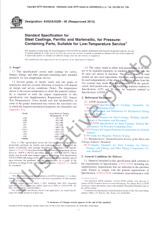We need your consent to use the individual data so that you can see information about your interests, among other things. Click "OK" to give your consent.
ASTM D8182-18
Standard Test Method for Alloy Classification of Wear Debris using Laser-Induced Breakdown Spectroscopy (LIBS)
Translate name
STANDARD published on 1.6.2018
The information about the standard:
Designation standards: ASTM D8182-18
Publication date standards: 1.6.2018
SKU: NS-852653
The number of pages: 9
Approximate weight : 27 g (0.06 lbs)
Country: American technical standard
Category: Technical standards ASTM
The category - similar standards:
Annotation of standard text ASTM D8182-18 :
Keywords:
alloy classification, chip debris, in-service oil, laser, LIBS, wear debris,, ICS Number Code 75.100 (Lubricants, industrial oils and related products)
Additional information
| Significance and Use |
|
5.1 In many cases, equipment failure modes are identified by wear debris that is not captured in used lubricating oil samples but captured on chip detectors, filters or by other means. Users of this technique include, but are not limited to, original equipment manufacturers (OEMs), commercial airlines, civil aerospace operators, maintenance repair and overhaul (MRO) facilities, and military maintenance personnel. |
| 1. Scope |
|
1.1 This test method describes a means for quantitative determination of wear debris found in in-service lubricants by laser-induced breakdown spectroscopy (LIBS). LIBS is an analytical technology that uses short laser pulses to create micro hot-plasma ablation of a material and then employs spectroscopic tools for analysis.2 1.2 This method covers the means for alloy classification and sizing of wear debris. Wear debris sources can include, but are not limited to: (1) chip collector and chip detector devices, 1.3 The method for alloy classification and sizing of wear debris is not limited to the list of alloys in Table 1. The instrument has the capability of including additional alloys and metals as required. 1.4 The values stated in SI units are to be regarded as standard. No other units of measurement are included in this standard. 1.5 This standard does not purport to address all of the safety concerns, if any, associated with its use. It is the responsibility of the user of this standard to establish appropriate safety, health, and environmental practices and determine the applicability of regulatory limitations prior to use. 1.6 This international standard was developed in accordance with internationally recognized principles on standardization established in the Decision on Principles for the Development of International Standards, Guides and Recommendations issued by the World Trade Organization Technical Barriers to Trade (TBT) Committee. |
We recommend:
Technical standards updating
Do you want to make sure you use only the valid technical standards?
We can offer you a solution which will provide you a monthly overview concerning the updating of standards which you use.
Would you like to know more? Look at this page.




 Cookies
Cookies
